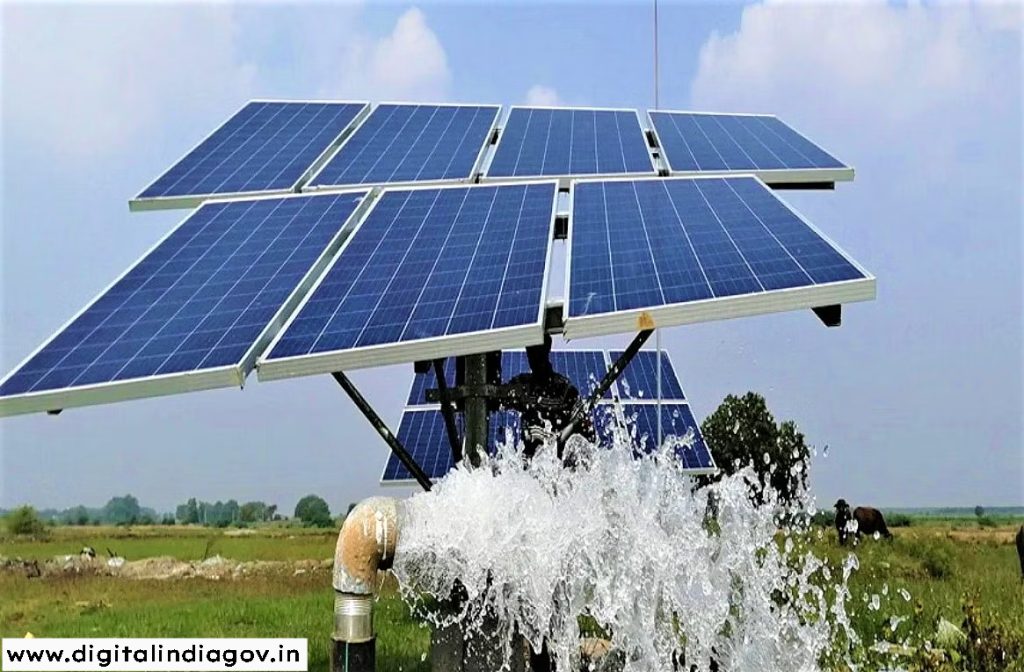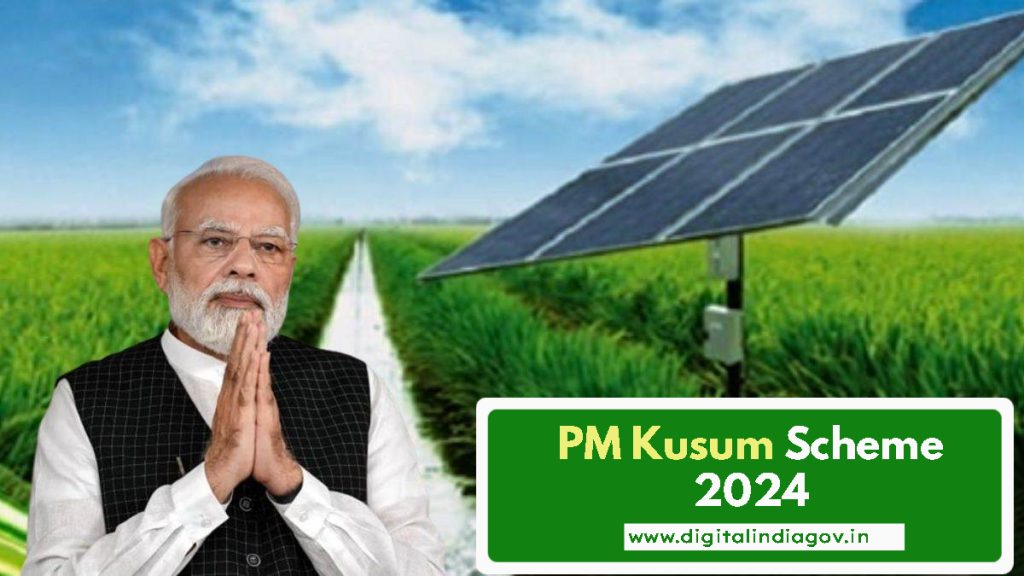PM Kusum Scheme 2024:- The Central Government launched the Kisan Urja Suraksha evam Utthaan Mahabhiyan, or KUSUM, program with the twin objectives of increasing India’s solar power generation and giving farmers access to the benefits of solar farming. For ten years, this program will receive funding of Rs. 48000 crores from the Union Budget 2018–19. A farmer income assistance and a de-dieseling program were two of the PM-KUSUM scheme’s current components that the Central Government modified in March 2021 in order to focus on solarizing agricultural feeders rather than pumps. By taking this action, farmers would not have to replace each old pump in a community with a solar pump.
Contents
PM Kusum Scheme 2024 Details
- Kusum Scheme Executed by: The Ministry of New and Renewable Energy is in charge of this program.
- The government will distribute the first batch of 1.75 million off-grid farm solar pumps.
- 10,000 Megawatts Arid land will see the installation of solar power facilities.
- The state-owned electricity distribution companies, or DISCOMS, will buy the excess solar energy produced by the farmers on bare lands. To purchase this power, DISCOMS will receive subsidies.
- The government will convert its current pumps and tube wells to solar power.
- Farmers who purchase solar pumps will receive a 60% subsidy. Their bank accounts will receive the direct transfer of funds. The federal and state governments will split this subsidy. A bank loan will cover thirty percent of the total expenditure. Therefore, the farmers will just need to bear the remaining 10% of the costs.
- Three elements make up the accepted scheme:
- Component-A: The installation of tiny solar power plants with a maximum capacity of two MW will add 10,000 MW of solar power.
- Component B: Setting up twenty lakh independent agricultural pumps that run on solar power
- Solarization of the 15 lakh currently in use grid-connected agricultural pumps is Component C.

Also Read:- PMVVY Scheme, Digitize India, Digitize India Platform, Work From Home Jobs, Celebrity Phone Number
Background
- India has pledged to raise the installed capacity of electricity from non-fossil fuel sources to 40% by 2030 as part of its Intended Nationally Determined Contributions (INDCs).
- The objective for grid-connected solar power projects has been approved by the Cabinet to be increased from 20,000 MW to 1,000,000 MW by 2022.
Objectives of PM Kusum Scheme 2024
- The primary goal of PM Kusum Yojana is to help farmers install off-grid solar pumps in their rural communities in order to lessen their reliance on places that are linked to the grid.
- Securing the farmers’ access to water and finances is one of the program’s key goals.
- Moreover, PM Kusum Yojana would guarantee that farmers can install solar power-generating equipment on otherwise unusable land and sell the electricity they produce to businesses.
- As a result, this plan will also guarantee that farmers’ non-agricultural income increases.
Latest information on PM Kusum Scheme 2024 –
- The farmer-oriented project, which involves decentralized solar power production of up to 28,250 MW over a five-year period, has benefited from the farmer focus of the KUSUM scheme.
- Under the Kisan Urja Suraksha evam Utthaan Mahabhiyan (KUSUM) initiative, farmers would be able to build up solar power installations on their barren fields and sell extra power to the grid, generating additional revenue for them.
- The government’s Budget for 2020–21 increased the program’s reach by offering support to 20 lakh farmers for the installation of independent solar pumps and another 15 lakh farmers for the solarization of existing grid-connected pump sets. As a result, farmers will be able to install solar power-generating equipment on their unused property and sell it to the grid.
PM Kusum Scheme 2024 Benefits
- It will allow solar energy production to become more decentralized.
- We’ll maintain control over DISCOMS transmission losses.
- There will be a significant decrease in the amount of subsidies that DISCOMS in the agriculture sector must pay.
- Farmers will be able to sell the excess electricity produced by the solar plants positioned on their arid fields to the grid as a result.
- It is going to give the growing green economy in India a boost.
- Additionally, the plan has the potential to directly create jobs. Based on existing research, every MW of small-scale solar installation generates around 24.50 job-years. For both skilled and unskilled people, the program is therefore expected to create employment opportunities equal to 7.55 lakh job-years in addition to growing self-employment.
- Additionally, the program will help India’s agriculture sector transition away from diesel. This suggests that new diesel pumps will replace the current ones.
- The adoption of this program will also benefit farmers in other ways, such as energy efficiency, water security, and conservation of water.

Also Read:- PMEGP Scheme List 2024
Features of PM Kusum Scheme 2024
- It was originally planned for the Central Government to distribute 1.75 million off-grid agricultural solar pumps.
- The barren lands belonging to the farmers will host approximately ten thousand Megawatt solar power installations.
- The state electricity distribution companies, or DISCOMS, will purchase any excess electricity generated by the solar power plants built on these barren sites.
- In order to purchase this electricity, the DISCOMS will also be eligible for subsidies.
- Farmers participating in this scheme will receive a direct benefit transfer (DBT) subsidy of around 60% on solar pumps. The farmers will receive this subsidy immediately into their bank accounts.
- The federal and state governments will share this subsidy, with the remaining thirty percent going towards loans to the farmers.
- So, the farmers will only have to shoulder 10% of the expense.
PM Kusum Scheme 2024 Drawbacks
- Water table depletion: Farmers continue to pump water since the recurring cost of electricity is so low as a result of power subsidies, causing the water table to decline. Due to the need for more costly solar panels, switching to greater capacity pumps in a solar project becomes considerably more difficult if the water table falls.
- The plan, which focuses on pumps with 3 HP and higher capacity, has excluded a sizable part of farmers—nearly 85% of them are small and marginal farmers. As a result, solar pumps are not reaching the majority of farmers. Additionally, small-sized pumps are restrictive for farmers due to the reality of low water tables, particularly in North and certain areas of South India.
- Problem with Logistics: The equipment itself is an issue of availability domestically. The supply of solar pumps remains a problem, even though domestic vendors have little trouble providing pumps. To make matters worse, the strict DCR (Domestic Content Requirements) has forced solar equipment manufacturers to source more domestic cells.
Way Forward with PM Kusum Scheme 2024
- Bring States Together: The success of this decentralized solar power program depends on the agreement between the Centre and the States. The Centre, States, and other stakeholders must agree before any changes to India’s power structure can be made.
- Profitable Solar Energy Pricing: Given the obstacles posed by higher implementation and comprehensive maintenance costs, the plan should offer a greater incentive in terms of benchmark prices to encourage effective implementation and meaningful participation from stakeholders.
- Sustainable Agriculture: In addition to converting to solar energy, farmers should use drip irrigation, which uses less water and energy while producing more crops.
Challenges of the PM Kusum Scheme 2024
- High initial costs: Installing solar power plants and solar pumps comes with a hefty initial cost. The apparatus’s initial setup expenses could be a barrier to adoption.
- Lack of technical understanding and awareness: It’s possible that many farmers in rural areas are unaware of the advantages and complexities of solar energy solutions. It’s possible that they lack the expertise needed to run and maintain solar power facilities and pumps.
- Obtaining financing: It can be difficult to obtain financing for the installation of solar power plants and pumps. It’s possible that farmers lack the necessary paperwork or collateral to obtain loans.
- Maintenance and service support: In order for solar pumps to function as effectively as possible, routine maintenance is necessary. However, access to replacement parts and repair services could be restricted in remote rural areas.
- Weather dependence: In areas with insufficient sunlight, solar pumps’ capacity to produce power may be affected. Farmers who depend on these networks for electricity and irrigation may face difficulties as a result.
- Problems with grid connectivity: It could be difficult in some areas to link solar power plants and pumps to the grid. Inadequate infrastructure or unstable electrical grid connections could be at blame for this.
- Administrative and implementation challenges: Effective execution of the PM-KUSUM system requires coordination between numerous parties.
- Land appropriateness and availability: Finding appropriate land for solar power plants can be a challenge in putting the plan into action.

Also Read:- Agneepath Scheme Apply
FAQ’s
Q. What is the scheme of Kusum?
Ans- The Pradhan Mantri Kisan Urja Suraksha evam Utthaan Mahabhiyaan (PM-KUSUM) plan was introduced by the Union Ministry of New and Renewable Energy (MNRE) last year to promote solar energy. The program intends to add 25,750 MW of additional solar and another renewable capacity by 2022 with a total of Rs. 34,422 Crore in central financial support.
Q. When did PM Kusum get its start?
Ans- In March 2019, the PM-Kusum Yojana received administrative clearance, and in July 2019, guidelines were formulated. The Ministry of New and Renewable Energy (MNRE) introduced this program to install solar power plants and other renewable energy sources around the country.
Suggested Link:- Our Jharkhand
@PAY
